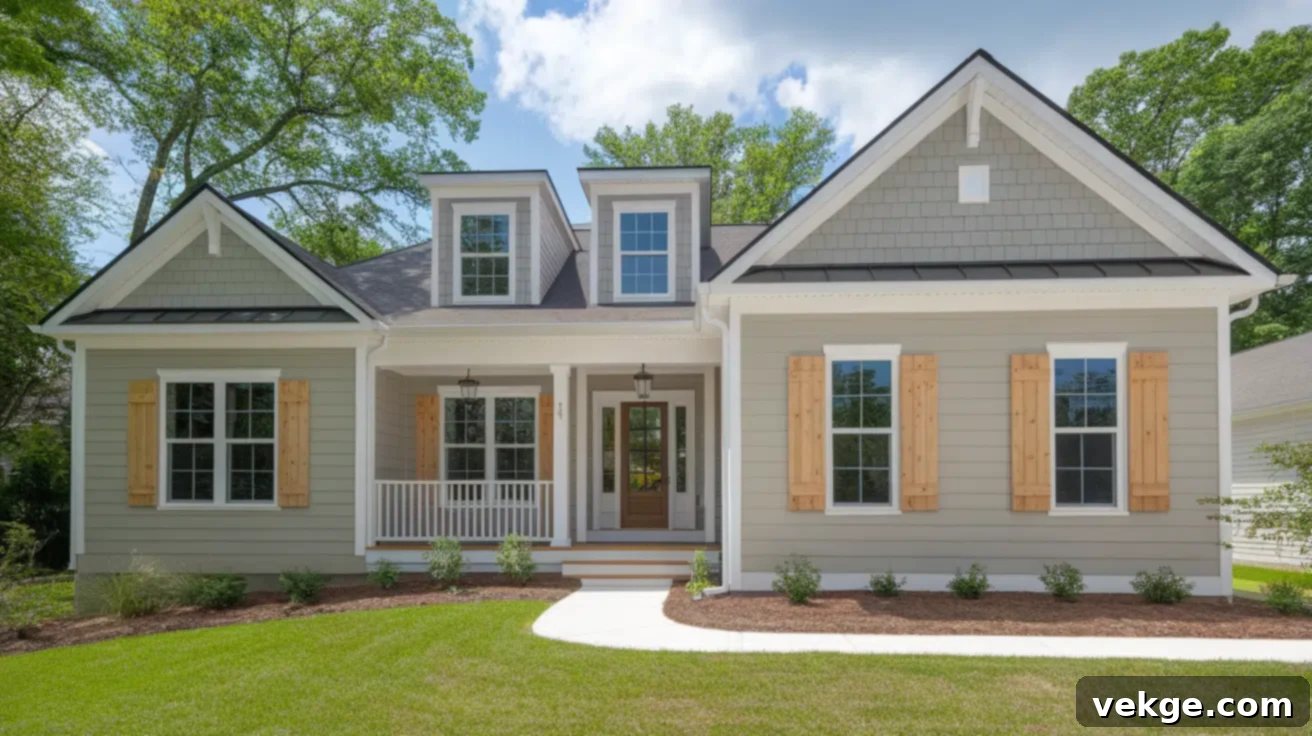Discover Serenity: The Ultimate Guide to Sherwin-Williams Lazy Gray (SW 6254) Paint Color
Some colors possess a unique ability to ground a space, making everything feel calm and harmoniously settled. Sherwin-Williams Lazy Gray (SW 6254) exemplifies this perfectly. It’s a beautifully soft, light-to-medium gray that embraces a room without demanding too much attention. Its versatile nature allows it to shine in diverse settings, from sun-drenched rooms and cozy, shaded corners to expansive walls and even stylish cabinetry.
If you’re navigating the vast spectrum of gray paint colors, seeking a hue that offers profound calmness without appearing flat or lifeless, Lazy Gray is an exceptional contender. It masterfully blends just the right amount of color with a serene quietness, creating an atmosphere of understated elegance. Once you witness this remarkable shade in action, its subtle charm and adaptability become truly undeniable.
This comprehensive guide compiles everything you need to know before introducing Lazy Gray into your home. We’ll delve into its intricate characteristics, explore how it transforms under various lighting conditions, detail its ideal applications in different areas of your house, and provide expert pairing suggestions to help you achieve a cohesive and stunning design.
Understanding Sherwin-Williams Lazy Gray (SW 6254)

Lazy Gray (SW 6254) by Sherwin-Williams stands out as a wonderfully soft, balanced gray defined by its gentle blue undertone. This particular nuance positions it comfortably between the warm and cool color families, making it an incredibly easygoing and adaptable choice. Its versatility allows it to seamlessly integrate into a vast array of spaces and design aesthetics, from creating a cozy, restful ambiance in bedrooms to lending a sophisticated, modern edge to contemporary living rooms.
Basic Color Profile and Characteristics
To truly appreciate Lazy Gray, let’s look at its fundamental specifications:
- HEX code: #BEC1C3
- LRV (Light Reflectance Value): 54.13
- Color family: Light gray with a soft blue undertone
With an LRV of 54.13, Lazy Gray sits comfortably in the mid-range of light reflectance. This means it’s neither too dark to weigh down a room nor too light to wash out on the walls. It has enough depth to provide a distinct presence, yet it’s light enough to feel airy and expansive. As a core member of Sherwin-Williams’ neutral gray lineup, it offers a consistently quiet and clean presence that serves as an excellent backdrop for various design elements. It truly excels when you desire walls that feel inherently calm and composed without the risk of them receding entirely into the background or appearing dull. Lazy Gray is available in all standard paint finishes, including the light-absorbing matte, the versatile eggshell and satin, and the slightly glossier semi-gloss, which is perfect for trim or cabinetry.
Exploring Lazy Gray’s Subtle Undertones
The magic of Lazy Gray lies within its soft blue undertone, a characteristic that subtly reveals itself and shifts in prominence depending on the surrounding light. It’s crucial to note that this blue is never stark or icy; instead, it provides a steady, soothing coolness that instills a peaceful and serene feeling in any room.
- In bright natural light: Particularly in south-facing rooms or those with abundant sunlight, the blue undertone becomes more apparent. This makes the gray appear wonderfully crisp and clean, yet it retains its signature softness, preventing it from feeling cold or stark.
- In north-facing rooms: With cooler, indirect light, Lazy Gray tends to lean a bit more into its blue undertone, offering a distinctly cool and serene vibe. It can feel quite sophisticated in these settings.
- In east or west-facing rooms: As the light shifts throughout the day, Lazy Gray showcases its balanced nature. In the morning, it might appear crisper with more noticeable blue, while in the afternoon or evening, it can lean into a truer gray.
- In low or artificial light: When natural light is scarce or under the influence of artificial illumination, the color tends to appear slightly deeper and closer to a pure, balanced gray. Here, the blue undertone gracefully recedes into the background, becoming a subtle whisper rather than a dominant feature. Using warmer-toned light bulbs (like those in the 2700K-3000K range) can help maintain a cozy and inviting balance, ensuring the room always feels welcoming.
This remarkable flexibility in tone makes Lazy Gray an ideal choice for a multitude of spaces, including tranquil bedrooms, refreshing bathrooms, and inviting shared living areas. It consistently delivers a calm, collected, and put-together aesthetic without ever feeling visually heavy or overwhelming.
Lazy Gray in Different Rooms and Applications
Lazy Gray’s inherent versatility allows it to transcend various rooms and surfaces, consistently delivering a cohesive and adaptable look that suits a wide spectrum of design styles. It excels at imparting a sense of softness and balance, ensuring a space never feels overly dark or monotonously flat.
Living Rooms: A Foundation of Calm
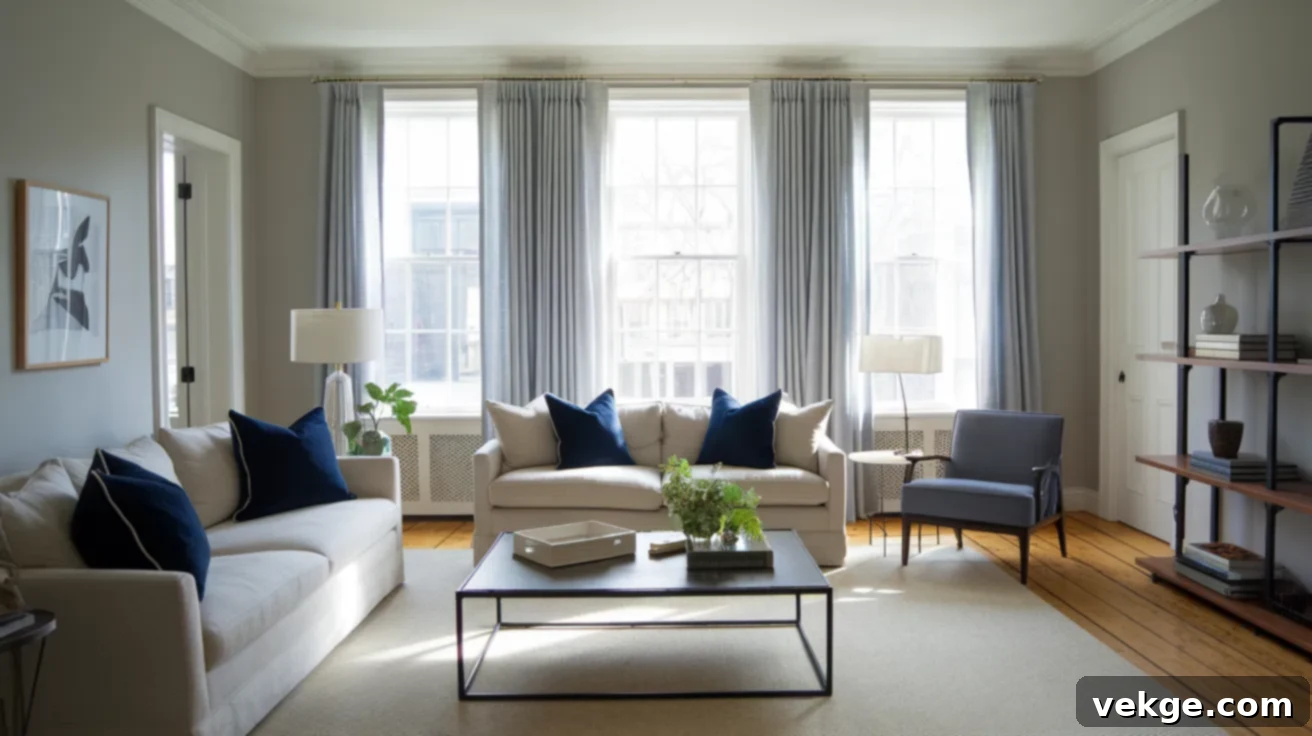
In living rooms, Sherwin-Williams Lazy Gray provides an exquisite foundation of calm, making it effortless to build a cohesive design scheme around it. Its soft blue-gray tones pair beautifully with a variety of soft furnishings, from plush neutral sofas and elegant light-colored curtains to textured woven accents like jute rugs or rattan furniture. To introduce dynamic interest, consider contrasting it with elements like sleek black metal accents, rich dark wood furniture, or deep blue decorative pieces like throw pillows or artwork. Lazy Gray works equally well on all four walls, enveloping the space in serenity, or as a striking feature wall behind open shelving, a prominent fireplace, or a modern TV unit.
Bedrooms: Your Serene Retreat
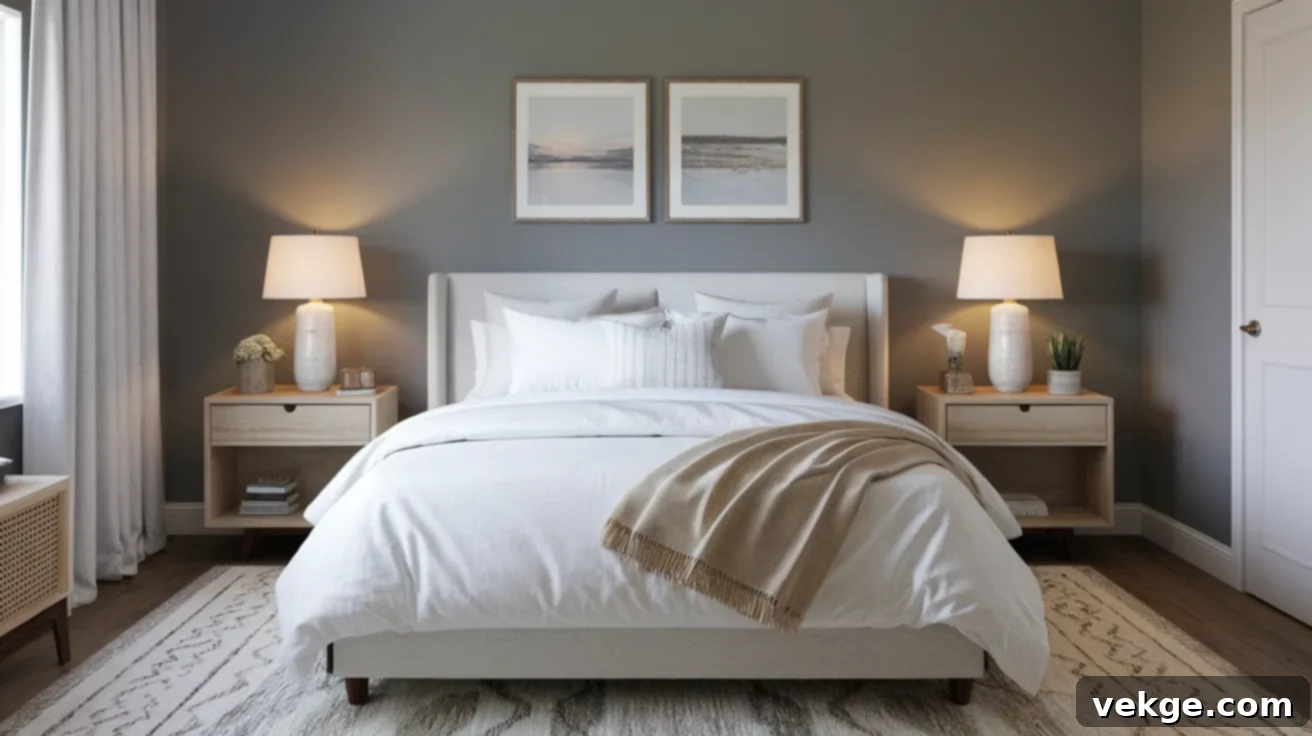
Transform your bedroom into a soft, restful sanctuary with Lazy Gray. This hue helps create an atmosphere conducive to relaxation without ever feeling sterile or too cold. It looks particularly stunning alongside crisp white or creamy beige bedding, creating a layered and inviting look. Enhance the comfort with textured rugs and light wood furniture, which add warmth and natural beauty. To cultivate an even cozier ambiance, incorporate warm lamps or install dimmable light bulbs. Whether applied to all walls for a fully immersive feel or just behind the headboard as an elegant focal point, Lazy Gray ensures a bedroom environment that is simple, chic, and effortlessly relaxing.
Bathrooms: Freshness and Sophistication
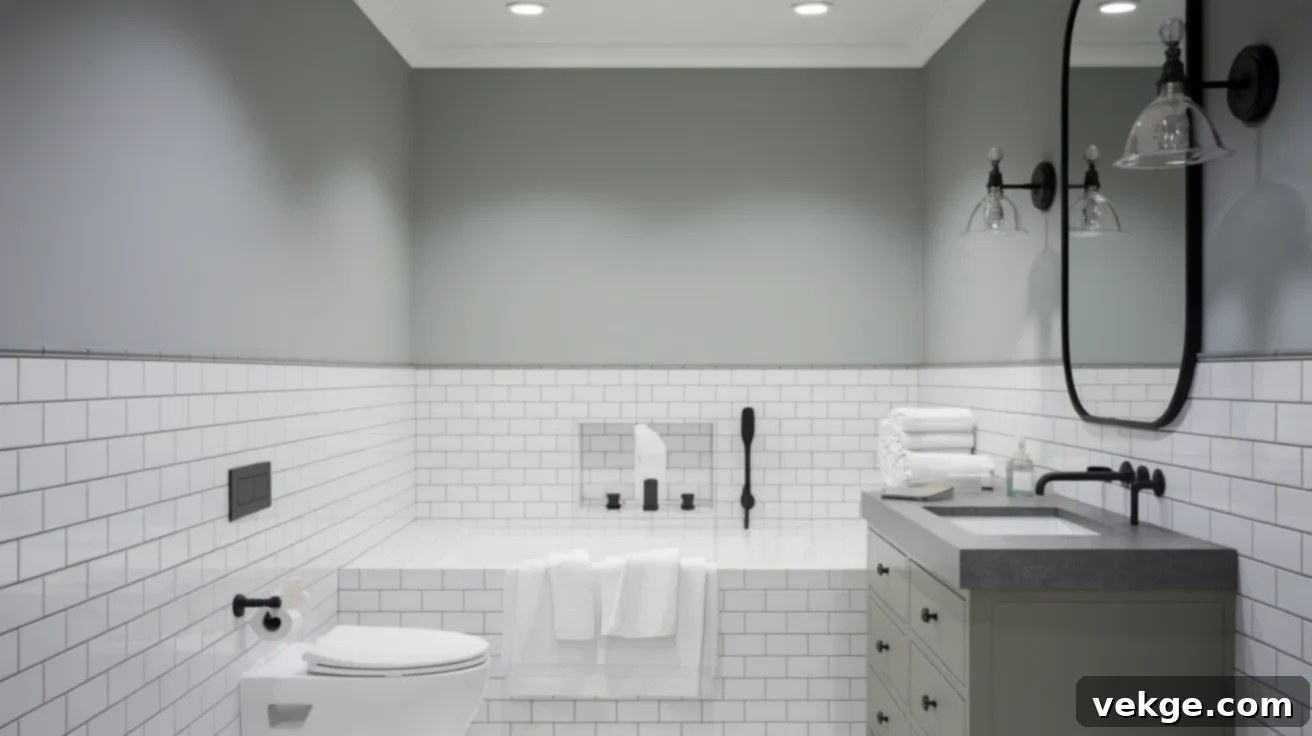
Lazy Gray brings a distinct sense of freshness and pristine cleanliness to bathrooms. Its gentle nature pairs exceptionally well with classic white subway tile, elegant gray stone finishes, or brushed metal fixtures in finishes like black, silver, or even brushed gold. The subtle blue-gray undertone introduces a tranquil stillness that elevates the space without making it feel confined or small. Consider applying it to bathroom walls, built-in shelving, or even a painted vanity for a cohesive look. Complete the serene aesthetic with soft, luxurious towels and minimalist decor, allowing the color to speak for itself.
Kitchens and Cabinets: Subtle Elegance
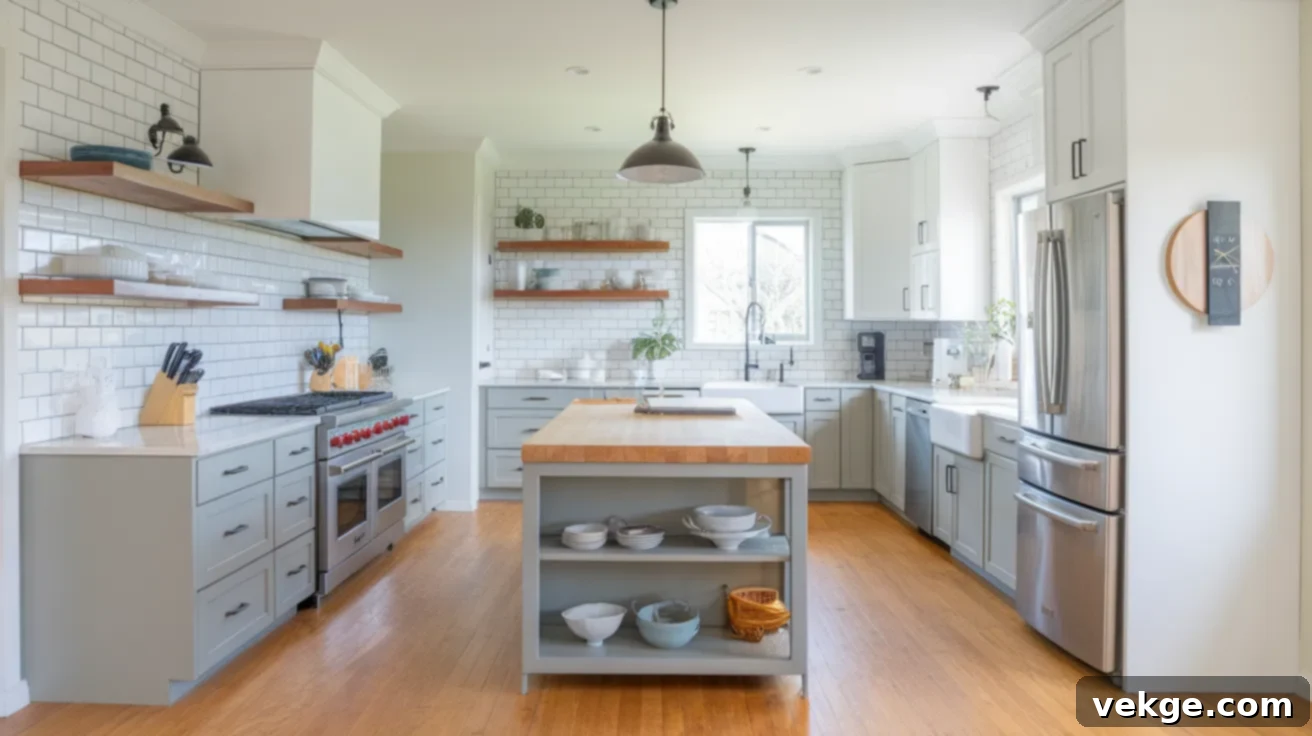
In the kitchen, Lazy Gray shines with its subtle elegance. This color beautifully complements kitchens that feature a harmonious blend of white tile backsplashes, warm wood flooring, and light-colored countertops. It is an excellent choice for both kitchen walls and cabinetry, particularly effective when used on lower cabinets or a kitchen island, where it can provide a grounding contrast. The color offers just enough depth to stand out and define these elements without overwhelming the functional space. Lazy Gray adapts wonderfully to both sleek, modern kitchen layouts and more traditional or classic designs, proving its immense versatility.
Exteriors: Timeless Curb Appeal
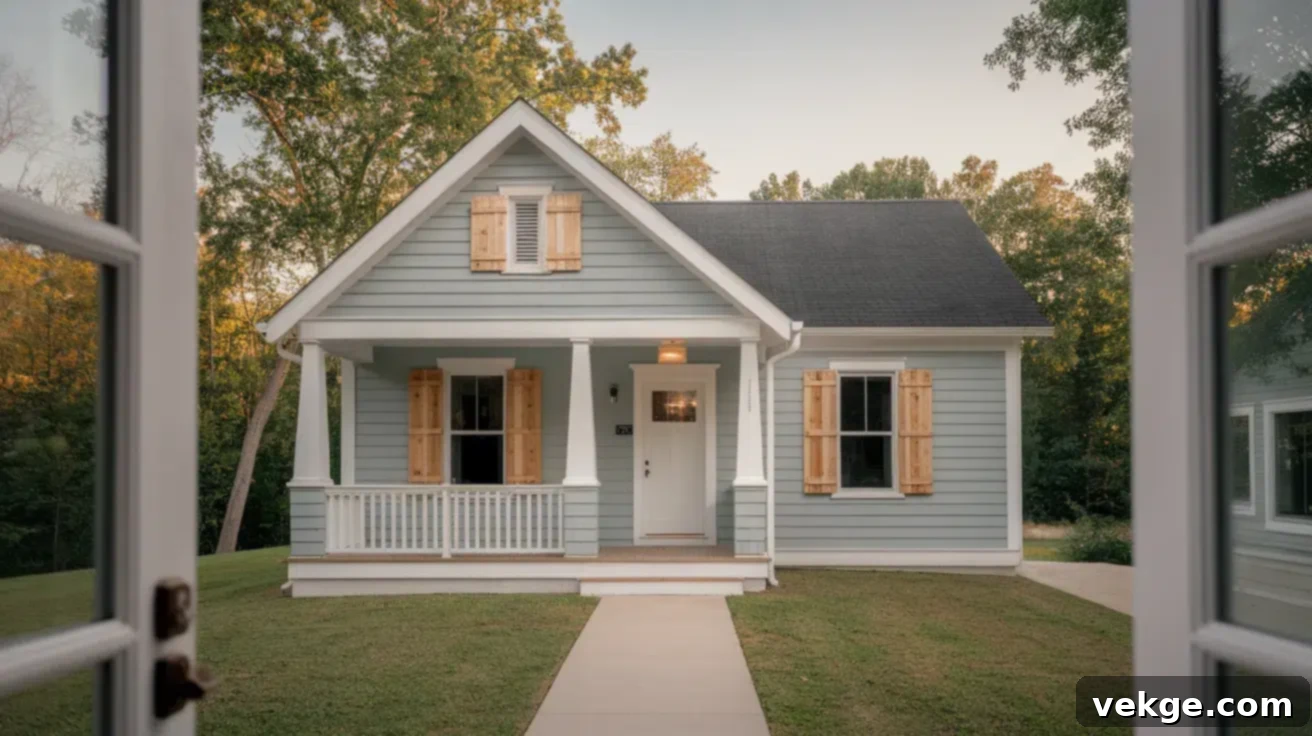
Lazy Gray demonstrates remarkable durability and aesthetic appeal for home exteriors, making it a robust and sophisticated option. Utilize it on your home’s siding, pairing it with crisp white trim for a polished and neat finish that enhances curb appeal. Alternatively, combine it with natural wood shutters or accents for a softer, more organic feel that blends beautifully with landscaping. The consistent tone of Lazy Gray ensures it holds up well even in full sunlight, maintaining its balanced gray without leaning too heavily into its blue undertone. It imparts a steady, timeless look to porches, garages, or front doors, contributing to a simple yet enduring exterior aesthetic.
Lazy Gray vs. Other Sherwin-Williams Grays: A Detailed Comparison
If you’re drawn to the serene charm of Lazy Gray but wish to explore similar options, Sherwin-Williams offers several other shades that provide a comparable feel with subtle variations in tone or depth. Understanding these differences can help you select the perfect gray for your specific needs.
Lazy Gray vs. Misty (SW 6232)
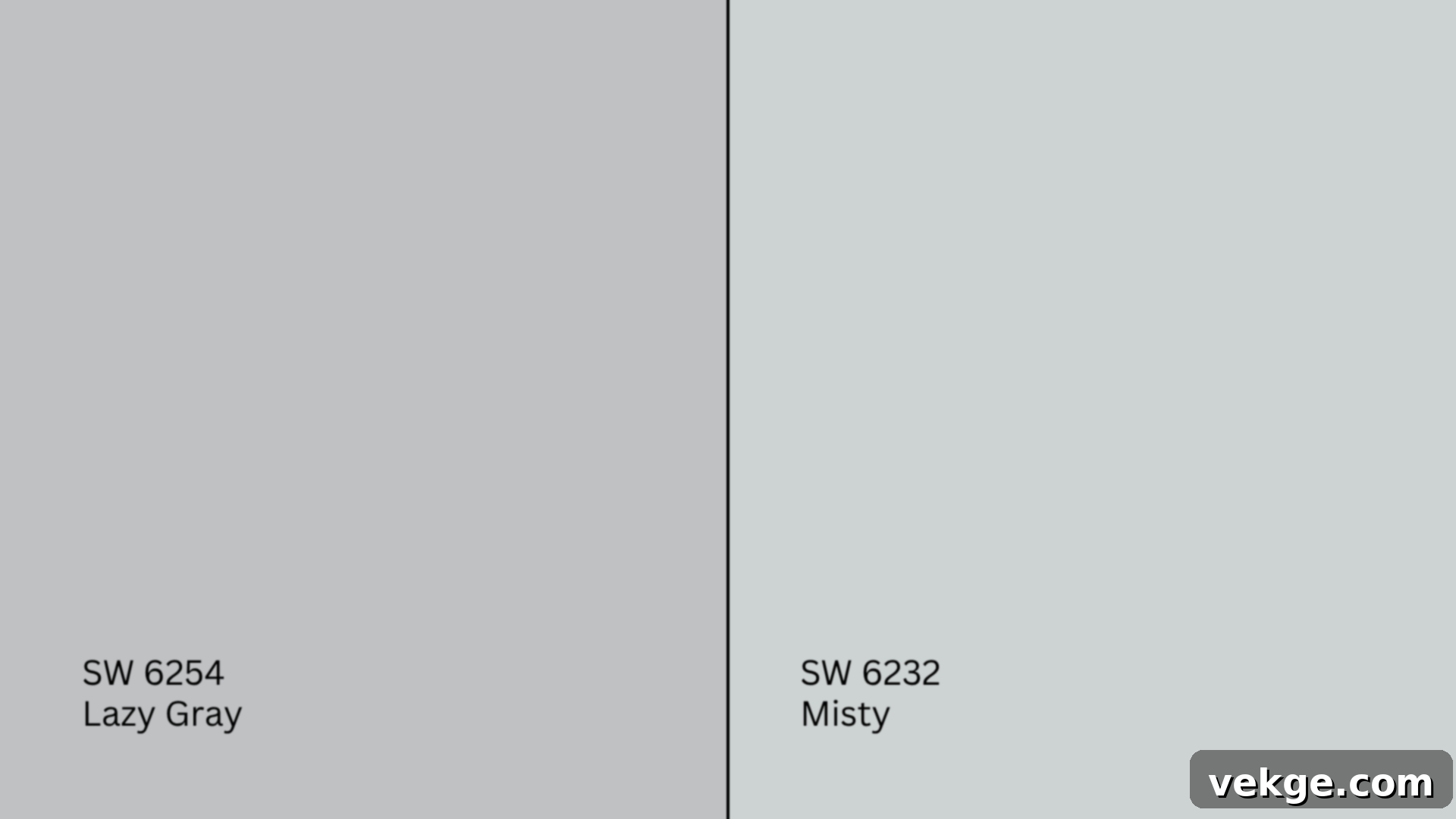
Misty (SW 6232, #CDD2D2) is a soft, cool gray that carries a noticeable green-blue undertone, creating a mood that is somewhat similar to Lazy Gray, but with distinct differences. Misty has an LRV of 64, making it significantly lighter and airier than Lazy Gray.
- Misty typically reads as a more pronounced blue-green in well-lit rooms, giving it a fresh, almost ethereal quality. It often evokes a coastal or spa-like atmosphere.
- Lazy Gray, with its LRV of 54.13, feels more grounded and possesses a slightly deeper pigment. Its blue undertone is steadier and more universally neutral in its effect, making it less likely to lean green.
Choose Misty if your preference is for a brighter, breezier, and slightly more colorful cool gray. Opt for Lazy Gray when you desire a more centered, stable gray that offers a touch more depth and a consistent serene feel.
Lazy Gray vs. Reflection (SW 7661)

Reflection (SW 7661, #D3D5D3) is a pale, crisp silver-gray, excellent for open, contemporary spaces. With an LRV of 66, Reflection is quite bright and reflects a substantial amount of light.
- Reflection is inherently cooler and presents a more refined, almost silvery edge, particularly in direct daylight. It’s the epitome of a clean, minimalist gray.
- Lazy Gray, despite its cool undertone, carries more body and a subtle hint of warmth, especially apparent under softer or artificial lighting conditions. It feels less stark and more inviting.
Select Reflection if your aim is a sharp, airy, and distinctly modern finish that emphasizes crispness. Choose Lazy Gray for a cozier, more settled, and approachable gray that offers more visual weight without being dark.
Lazy Gray vs. Olympus White (SW 6253)
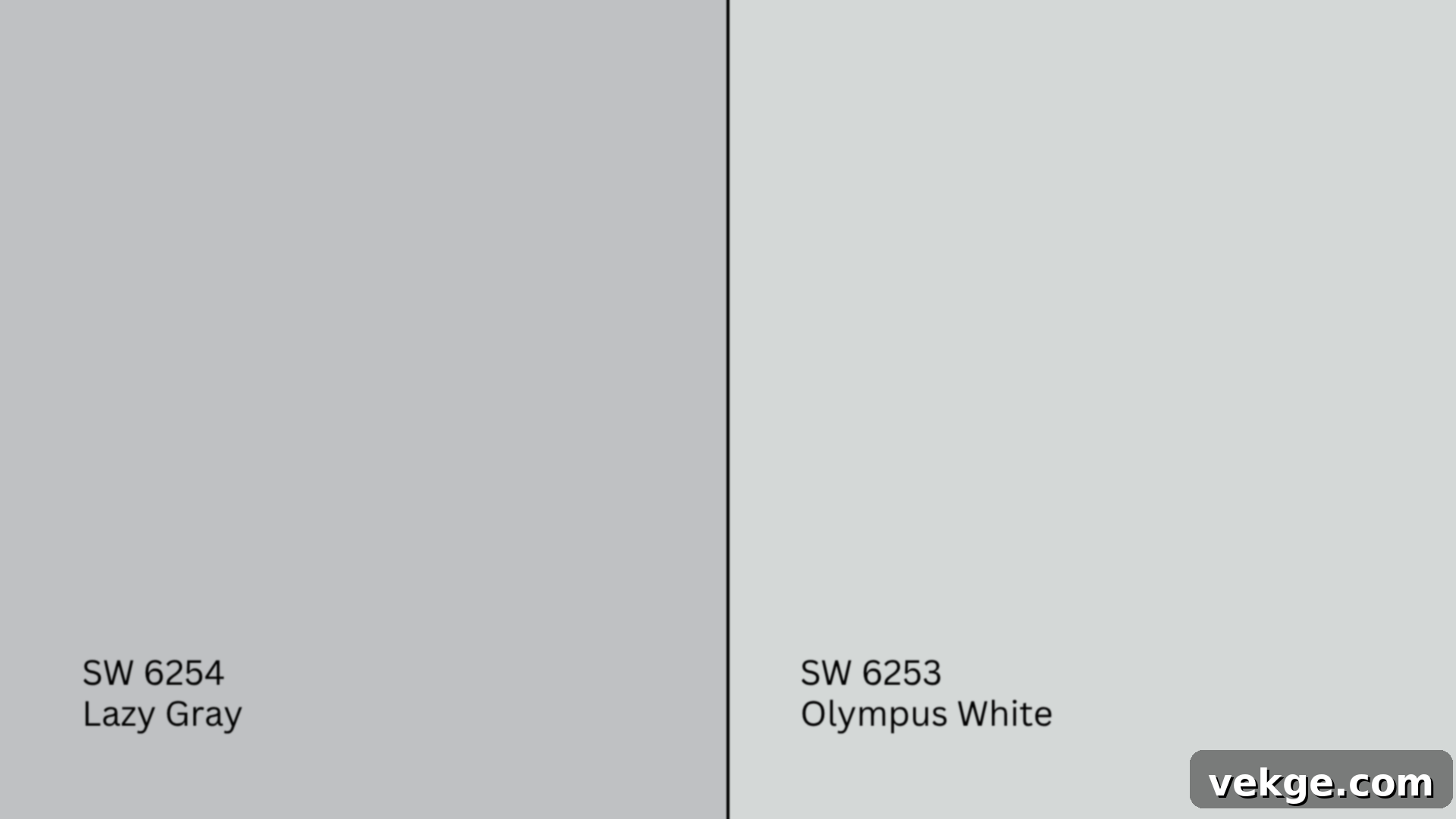
Olympus White (SW 6253, #D4D8D7) is a very pale, almost icy gray that features prominent cool blue undertones. With a high LRV of 68, it often acts more like an off-white in many settings, ideal for minimalist and airy environments.
- Olympus White is substantially lighter than Lazy Gray and can often appear almost pure white in rooms bathed in strong sunlight, making it perfect for an almost-white look with a hint of cool.
- Lazy Gray, in contrast, demonstrates far greater color depth and feels significantly less stark. It maintains its gray identity more robustly, especially when applied across all four walls.
If your design goal is a barely-there gray that borders on white, Olympus White might be your ideal choice. For a gray that offers more undeniable presence and a clearer sense of color, Lazy Gray provides a stronger, more enduring statement.
Lazy Gray vs. Krypton (SW 6247)

Krypton (SW 6247, #B8C0C3) is a cool, mid-toned gray that features a much more distinct and noticeable blue cast, leaning deeper than Lazy Gray. Its LRV is 52, making it slightly darker than Lazy Gray.
- Krypton reads as noticeably bluer, particularly in cooler-lit or shaded rooms, making it a stronger contender if you’re seeking a gray with a clear blue identity.
- Lazy Gray, with its gentler blue undertone, feels more balanced and muted. Its softer tone makes it highly adaptable, playing equally well with both warm and cool accent colors.
Opt for Krypton if you desire a strong, cool-gray statement that unequivocally showcases its blue side. Stick with Lazy Gray for a softer, more adaptable gray that offers serenity without the pronounced blue intensity.
Undertone and LRV Comparison Table
| Paint Color | Undertones | LRV | Warm or Cool |
|---|---|---|---|
| Lazy Gray (SW 6254) | Soft Blue-gray | 54.13 | Cool |
| Misty (SW 6232) | Blue-green | 64 | Cool |
| Reflection (SW 7661) | Cool Silver-gray | 66 | Cool |
| Olympus White (SW 6253) | Soft Blue | 68 | Cool |
| Krypton (SW 6247) | Distinct Cool Blue-gray | 52 | Cool |
While all these colors reside within the expansive cool gray family, their unique undertones and LRV values cause them to appear quite differently depending on factors like natural light exposure and room orientation. It is always highly recommended to test generous swatches of your preferred colors directly in your space to truly grasp how each shade interacts with your home’s unique environment before making a final decision.
Color Pairings That Harmonize With Lazy Gray
Lazy Gray’s versatile nature makes it an excellent canvas, pairing beautifully with an extensive range of both cool and warm accents. Whether your design vision leans towards striking contrasts or a seamless, flowing aesthetic, Lazy Gray offers abundant opportunities for creative color combinations.
Recommended Trim Colors for Lazy Gray
Selecting the right trim color can significantly enhance Lazy Gray, bringing out its tranquil tone without creating jarring clashes. You can opt for crisp, warm, or cool whites, each offering a distinct stylistic effect:
- Pure White (SW 7005, #EDECE6): This is a highly popular choice for baseboards, ceilings, and doors. Pure White offers a clean, crisp contrast against Lazy Gray, making the gray appear slightly richer and more pronounced. It’s perfect for achieving a fresh, contemporary look.
- Greek Villa (SW 7551, #F0ECE2): If your preference is for a softer, slightly warmer white, Greek Villa is an excellent option. It subtly warms up Lazy Gray’s cool edge, fostering a cozy and inviting atmosphere that feels less stark than a bright white.
- Extra White (SW 7006, #EEEFEA): For a bright, exceptionally clean, and almost clinical white, Extra White creates a sharp and pristine contrast. It’s an ideal complement in modern or minimalist spaces where a sense of clarity and spaciousness is desired.
Accent Colors That Beautifully Complement Lazy Gray
Introducing accent shades is an effective way to layer interest and balance into a space featuring Lazy Gray. These carefully selected colors can inject warmth, add depth, or enhance the overall softness of your room’s palette:
- Naval (SW 6244, #2F3D4C): This deep, rich navy offers a sophisticated contrast and luxurious depth without overwhelming the calm of Lazy Gray. Use it for an accent wall, velvet upholstered furniture, or in decorative items like vases and artwork for a truly elegant statement.
- Mannered Gold (SW 6130, #C19763): For a warm, muted mustard yellow, Mannered Gold effortlessly breaks up the cool tones of Lazy Gray, introducing a natural, earthy warmth. Consider incorporating it through throw pillows, a statement armchair, or carefully chosen decor for a touch of vintage charm.
- Golden Fleece (SW 6388, #D6AD78): A lighter, more luminous take on ochre, Golden Fleece still feels wonderfully grounded and earthy. It provides a softer pop of sun-kissed warmth compared to Mannered Gold, perfect for textiles, curtains, or smaller accent pieces.
- Clary Sage (SW 6178, #ACAD97): This fresh, muted sage green offers a harmonious, organic pairing with Lazy Gray. It beautifully complements natural wood elements and brings a soothing, botanical touch to any space. Use it in plants, subtle artwork, or even a piece of painted furniture for an earthy, tranquil vibe.
Paint Finish Recommendations for Lazy Gray
The choice of paint finish goes beyond mere durability; it significantly influences how Lazy Gray appears and feels in your space. Each finish uniquely interacts with light, altering the color’s perception. Here’s a breakdown of how various finishes perform and their impact on Lazy Gray:
- Matte: This finish is superb for low-traffic areas like ceilings and bedrooms, as its non-reflective surface effectively hides minor wall imperfections. Matte paint gives Lazy Gray a deeply soft, almost velvety, and incredibly cozy appearance. The cool blue undertones tend to feel more muted and absorbed, especially in low or shaded lighting conditions, contributing to a serene and enveloping atmosphere.
- Eggshell: Offering a subtle, low-sheen finish, eggshell is a versatile and popular choice for living rooms, dining areas, and hallways. It adds a gentle luminosity that keeps the color feeling bright and alive without being overtly shiny. This finish helps Lazy Gray maintain its calm and clean aesthetic, providing a touch more visual depth and character than a matte finish.
- Satin: Ideal for high-traffic zones such as kitchens, bathrooms, and laundry rooms, satin provides a smooth, pearl-like sheen that is significantly more durable and easier to clean than matte or eggshell. The added glow from a satin finish can subtly enhance Lazy Gray’s blue undertone, making it appear slightly more prominent and crisp, especially in spaces with direct or overhead lighting.
- Semi-Gloss: This finish offers a higher sheen and maximum durability, making it perfect for trim, doors, and cabinetry. Semi-gloss on Lazy Gray cabinets will make the blue undertone stand out, creating a crisp, clean, and modern look that is also incredibly easy to maintain and wipe clean. It adds a sophisticated polish to these architectural details.
If you’re unsure which finish is right for your project, a practical tip is to apply a few test swatches of Lazy Gray in different finishes directly onto your wall. Observe these samples throughout the day under various lighting conditions – natural daylight, overcast light, and artificial evening light. This hands-on approach will give you the most accurate representation of how Lazy Gray will ultimately look and feel in your specific environment.
Sampling and Purchasing Options for Lazy Gray
Before committing to an entire gallon (or multiple gallons) of paint, wisely testing Lazy Gray in your actual space is an indispensable step. Factors such as natural light, room orientation, the size of the room, and even existing furniture and decor colors can significantly influence how this subtle shade reads on your walls.
Where to Get Peel-and-Stick Samples
The most convenient and mess-free method to sample Lazy Gray is by using peel-and-stick paint samples. These allow you to experience the true color without the commitment of painting directly on your wall:
- Samplize offers high-quality, large-format peel-and-stick samples made with real paint. They are removable, repositionable, and won’t cause any damage to your existing wall finish. This allows you to easily move the sample around to different walls and observe it at various times of the day.
- Local hardware stores, like Lowe’s or Home Depot, often carry physical color chips or small sample jars of Sherwin-Williams colors, which you can use to brush onto a poster board.
- Sherwin-Williams stores directly provide both physical swatch cards and small tester pots, enabling you to brush a small section onto your wall or a portable board for evaluation.
Remember to view your samples next to existing elements in your room, such as furniture, flooring, and other wall art, to ensure a harmonious color scheme.
Where to Buy Sherwin-Williams Lazy Gray Paint
Once you’ve confidently chosen Lazy Gray, purchasing the paint is straightforward, with both online and in-store options available:
- Sherwin-Williams.com provides the convenience of ordering directly from their official website. You can choose to have your paint delivered straight to your door or opt for in-store pickup at your nearest Sherwin-Williams location.
- Independent paint retailers that carry Sherwin-Williams products are another excellent option. They often have Lazy Gray in stock or can easily order it in your preferred finish and quantity. Supporting local businesses is an added benefit.
- Major home improvement stores, such as Lowe’s and some Home Depot locations, may also carry Sherwin-Williams paints. While stock can vary, they often have the capability to mix custom orders for specific Sherwin-Williams colors like Lazy Gray.
- Many locations now offer convenient curbside pickup or local delivery options. It’s always a good practice to call ahead to your chosen store to confirm the availability of Lazy Gray in your desired finish and to inquire about their current pickup or delivery services.
Conclusion: Embrace the Serene Appeal of Lazy Gray
There’s an undeniable steadiness and quiet confidence that defines Sherwin-Williams Lazy Gray (SW 6254). This remarkable paint color truly settles into a space, providing a serene foundation while still offering just enough color and character to make a distinct impact. Its gentle blue undertone, balanced LRV, and incredible adaptability make it a favored choice for designers and homeowners alike seeking a sophisticated yet understated gray.
By now, you have a comprehensive understanding of Lazy Gray – how its subtle undertones behave, where it can be most effectively utilized throughout your home, and what sets it apart from other popular gray shades. The next crucial step is to experience this color firsthand. Invest in a sample, place it in your space, and live with it for a day or two. Observe how it shifts with the changing light, how it complements your furnishings, and the overall mood it cultivates.
Remember, choosing the perfect paint color is a journey, not a race. Some colors, particularly nuanced ones like Lazy Gray, need a little time to fully reveal their potential and demonstrate how they integrate into your home’s unique environment. Keep these detailed tips and comparisons handy as you shop for samples and embark on your painting project.
Eager to explore more real-life paint tips, in-depth color breakdowns, and inspiring design ideas? Head over to other blogs on our website and discover your next favorite shade, transforming your living spaces with confidence and style!
